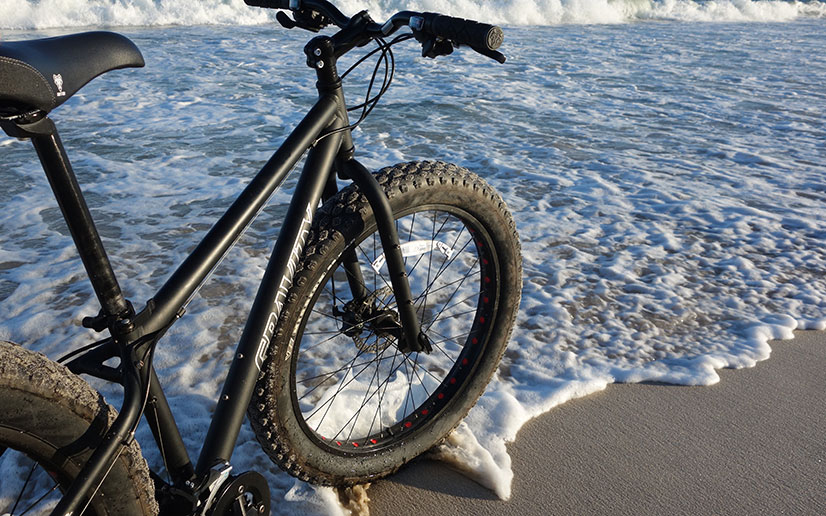Fat bikes - features of bicycles and reviews about them
The word "fatbike" comes from the English word "fat" - "fat". This is a bicycle with thick wheels. It was invented in the 80s by Mark Grunwald, a resident of Alaska, USA.
It was he who coined the term. Although one of the first mentions was the publication in 1932 of an advertising picture of a stuntman on a bicycle with fat tires.
Features of fatbikes

By its nature, a fatbike is a mountain bike, which differs only in wheels that have a large width. Otherwise, everything is the same - a frame made of chromolybdenum or aluminum and the same attachments.
With the exception of the fork, plump wheels are so good at cushioning and making the ride comfortable over any bumps that manufacturers tend to put rigid forks on them.
Although every rule has exceptions:
- Full suspension feta with both rear and front depreciation.
- Electrical.
- Carbon and titanium, having a lower weight compared to aluminum.
- Single speed bikes.
- Fat bikes with planetary gear.
Advantages and disadvantages

Like any other type, a fatbike has its pros and cons.
Clear advantages include:
- Attractive appearance, eye-catching.
- Excellent flotation on various types of surfaces.
- Versatility to the conditions of use.
The obvious disadvantages include the following:
- Increased weight.
- In small cities it is difficult to find a camera or a tire (in case of a serious cut, you will have to order it on the Internet).
- Quite high prices (although they are steadily creeping down thanks to the efforts of various Chinese manufacturers).
wheels

Wheels are the main feature. It is they who give the name to the type of bicycle. Thanks to them, the fat feels great off-road, significantly outperforming its less “fat” counterparts in terms of cross-country ability.
And thanks to the large volume of air and rather low pressure (from 0.2 to 2 atm, depending on the type of coating), an incredible smooth ride is achieved, despite the fact that there are stones, branches or dry asphalt under the wheels.
Usually the width of tires installed on fat bikes ranges from 3.5 to 4.5 inches, which is about 9-12 cm, but there are models with tires 5 inches or more. The width of the rims on all fat bikes is 65-100 mm.
Weight
The weight of most fat bikes most often ranges from 14-17 kg. Wheels - the main "fat mass" - weigh 3-4 kg each. The frame has a weight of around 2 kg, the fork, due to the lack of depreciation, allows you to save money - instead of the usual 2-2.5, it can weigh less than a kilogram.
At the annual exhibitions, manufacturers are constantly showing new models of bicycles made from various innovative materials and using lighter attachments. The weight of some copies reaches 12 kg, which puts them on a par with mountain bikes.
Appearance

The appearance of a fatbike always evokes emotions. Some like it right away, others are disgusted by the ridiculous combination of thin frame tubes and wide tires. But most importantly, it catches. The market for these bicycles in Russia and the CIS is only gaining popularity, and even in such large cities as Moscow and St. Petersburg it is still a curiosity to meet such a rare monster.
All feta according to their appearance and structure are divided into offset and non-offset (symmetrical). Offset (English offset) - offset to the side relative to the center.
It happens with the following components of any fatbike:
- Offset frame and fork - the shift of the feathers to the right by either 17.5 or 28 mm.
- Rim offset - the displacement of the spokes fastening to the right side relative to its center.
They are both designed to use standard 135mm wide MTB hubs on rims up to 100mm. Also allows the use of planetary bushings.
The advantages and disadvantages of offset are the following features:
- The main advantage is the ability to use popular MTB hubs.
- The second plus is the interchangeability of wheels. Both are assembled on the rear bushings and are easily swapped - front to rear and vice versa.
- The main disadvantage is that offset wheels are less stable and not as rigid as non-offset ones.
- Also, the disadvantages include an extremely unusual asymmetrical appearance.
Symmetrical non-offset fatbikes also have not been spared by a wave of positive and negative sides. These include:
- The main advantage is their popularity. The vast majority of them in their arsenal carry rear feathers for a 170 or 190 mm hub.
- The second plus, as opposed to the minus offset, is the strength of such wheels.
- The third nice bonus is the opportunity, in addition to thick ones, to assemble a set of 29-wheels for the summer and smooth roads.
- Minus number one. Lack of interchangeability of wheels, which is so useful on long trips and travels.
- The difference in standards (170, 190 and 197 mm bushings) imposes certain difficulties. Plus, the prices for these bushings and accessories for them are quite high.
Hinge

The hitch of modern fat bikes differs little from the usual mountain bikes, but there are still some features:
- Frameset - frame and fork, have a geometry that allows you to use wide, more than 3.5 inches, rubber.
- Rim widths from 65 to 100 mm are used.
- The carriage size is 100 mm (all popular standards are suitable). It is possible to install a system with an integrated shaft with the same size.
- On symmetrical fresets, rear bushings from 170 mm in size and front bushings of 135 mm are used.
- ShimanoDirectMount or ShimanoE-Type front derailleur.
- Some popular framesets (Pugsley, Moonlander, 9:zero:7, etc.) use two rear brakes.
Due to its versatility, the “fat man” is suitable for any season, skiing area and surface. It will perfectly cope with long-distance runs on smooth asphalt, it is only necessary to increase the pressure in the wheels.
Freshly fallen snow and sand will also not be an obstacle for him - wide tires at low pressure allow you to pass obstacles without digging in. They have long been used not only for simple skiing, but also as a daily transport from home to work.
Tourists rely on them due to their exceptional versatility and reliability. For many, it has become a style and lifestyle, fundamentally changing the feel of cycling. Everyday use of a fat bike does not require learning new skills. This is an ordinary bike, albeit a little unusual looking.
It allows you to go anywhere without thinking too much about the route. Where a mountain bike gets stuck in the mud, the “fat guy” will pass without even getting dirty. The main thing to remember about the pressure in the wheels, because this bike is more dependent on it than anyone else.
The best manufacturers and models

The manufacturer of the "top 1" at the moment is the American company Surly. It was they who began to mass-produce fat bikes, starting the production of their Pugsley model.
Eminent manufacturers such as Cube, TREK, Specialized or Scott do not miss their opportunity, bringing wonderful models to the market:
- Cube Nutrail.
- TREK Farley.
- Specialized Fatboy.
- Scott Big Jon.
But not only these large manufacturers keep the entire market. Every year more and more new players appear, mostly from China, filling the market with interesting, bright, with their own characteristics of bicycle models.
Prices and where to buy

Residents of big cities are lucky - the wave of popularity of fat bikes has reached them and many brands and models are available in sports stores.
Of course, if you want something more exclusive, you will have to search on the Internet and most likely order from abroad. But most of the no less interesting, and most importantly, cheaper models can already be bought in Russia.
In the lower caste of bicycles up to 40 thousand rubles, which are worth paying attention to, are:
- StelsNavigator 480 MD 2017 - 21,410 rubles.
- Stark Fat 26.2 D 2017 - 27,590 rubles.
- StelsNavigator 680 MD 2017 - 32270 rubles.
In the price range from 40 to 80 thousand rubles are the following representatives:
- Silverback Sphere Delight - 73,800 rubles.
- Author Su-Mo 2017 - 74,080 rubles.
- Specialized Fatboy SE 2016 - 79,333 rubles.
- Fuji Bikes Wendigo 26 1.1 2016 - 81,590 rubles.
- KTM Fat Flea 2016 - 94,070 rubles.
- Silverback Scoop Fatty 2017 - 98,700 rubles.
- Scott Big Jon 2017 - 120,185 rubles.
- Cube Nutrail Pro 2017 - 132,900 rubles.
Reviews

Well made with a nice design. Withstands my weight of 160 kg. I decided to lose weight and bought myself this monster. As they say, a fat bike for a fat person. In the city, a bicycle attracts a lot of attention, a couple of times the traffic police stopped on the road, asking what kind of unit it was.
Rating: At first I doubted buying this device for a long time, but I bought it anyway. Great bike. Price/quality is ok. Weight 14.2 kg, good attachment. Dashed for all the time 1200 km in the parks and the city - everything pleases!
Makarov Oleg (CRONUS Fatty 2016)
The advantages of this bike include high cross-country ability and excellent brakes. But due to the lack of shock absorbers, it is too stiff, although this is a matter of taste. In terms of behavior, I can highlight such points as: large wheels that dampen vibration, excellent handling and an excellent 20-speed transmission.
Medvedev24 (Trek Farley 6 2015)
Chinese fatbike. The overall impression is good, although not without a fly in the ointment. Chinese components are of mediocre quality, and there was not enough seatpost for a height of 180 cm. There are no complaints about the wheels, it rides perfectly on sand and stones. The bike is very fast, but quite heavy, because the frame is steel. It is quite suitable as a first bike for those who want to try fat.




